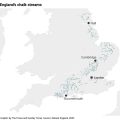Understanding Global Impacts of Hatchery Fish on Wild Salmonids

Photo: See1,Do1,Teach1/Flickr
Last week, we reported on a new study from Trout Unlimited that shows definitive proof of hatchery fish having a detrimental impact on wild salmonids across the globe, with the focus specifically on salmon and steelhead.
Today, we’ll dive into the details to help you understand why hatchery fish are harming wild salmonids, and what this means for the future of our fisheries, and fisheries management itself.
A team of scientists from Trout Unlimited, which includes Helen Neville, Senior TU Scientist, and John McMillan, the Science Director of The Conservation Angler, published a paper that synthesizes the results of global research into the impact of hatchery fish on wild salmon and steelhead. As salmon and steelhead stocks decline around the world, hatcheries release more and more fish to try and bolster populations. The biggest problem with a hatchery system, according to this new research, is the impact the hatchery fish have on the genetics of wild fish.
Hatchery fish can “harm wild salmonid populations through genetic impacts on fitness and diversity, and ecological impacts such as increased predation, competition for food and spawning sites, and susceptibility to disease. Hatchery fish also have lower survival rates and produce fewer offspring in the natural environment than their wild counterparts, which over time diminishes their effectiveness,” according to the research.
If you’ll recall a recent story here at MidCurrent, we discussed how an abundance of pink salmon – released from hatcheries in southeast Alaska – are literally smothering all fish in certain streams. So, the adverse impacts of hatchery fish on wild salmonid stocks is certainly a legitimate, pressing concern.
The research team led by TU scientists looked at papers from the past 50 years that discussed the impacts of hatchery fish on wild fish. Over 80% of “peer-reviewed research concluded that hatchery releases have had an adverse effect on wild salmonid populations, while just 3% showed a positive impact.”
A very small portion of the reviewed research showed beneficial impacts from hatchery fish. Per the research, “A small percentage of the literature reviewed found beneficial effects (3 percent of the publications included), which were primarily associated with recovery hatcheries aimed at providing a short-term boost to highly depleted wild populations threatened with extinction.”
What the team behind this research wants to make clear is that their focus here is on the large-scale “production hatcheries” that support ailing stocks of salmonids, especially salmon and steelhead.
Recovery hatchery programs – aimed at reintroducing fish to areas where they were extirpated – are generally more successful, and the researchers noted that “the new paper does not consider instances of successful reintroductions of extirpated salmonid stocks, as the focus of the literature review was on research documenting impacts to existing wild populations.”
Moving forward, it should be interesting to see how fisheries managers use this new research to guide their decisions. As the researchers note, “The results of this global scientific literature review clearly affirm that salmon, trout, and char hatcheries present a significant risk to wild salmonids through ecological and genetic impacts, even when using more modern supplementation hatchery programs and practices.”
It’s also worth noting that the researchers found key examples in their review of the literature that bucked the trend, so to speak. When used correctly, hatcheries involved in recovery programs (reintroducing extirpated fish) have been shown to either significantly reduce adverse effects, or even outrightly benefit, wild fish. These instances provide a framework for how to best use hatcheries moving forward, the researchers suggest.
The goal isn’t to demonize hatcheries. As Helen Neville explains, the hope is that this study can provide everyone with the information needed to make the best decision possible moving forward.
“We recognize that hatcheries play a significant role in specific regions where wild salmon and steelhead remain on the brink of extinction because of habitat degradation, including places where dams have drastically reduced wild production,” Neville continues. “In such places, hatchery salmon and steelhead, for instance, often serve as a vital lifeline to the lives, cultures, and well-being of Tribal Nations, and Trout Unlimited looks forward to continuing to work with Tribes and others toward essential actions, including dam removal, that can recover healthy and harvestable populations of wild salmon and steelhead. But, as this global research synthesis makes clear, we must take care to operate hatcheries in a manner that does not prevent wild salmonids from recovering.”
2023 Skeena Steelhead Returns Disappoint
Another Big Hole River Story











